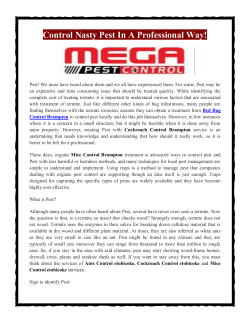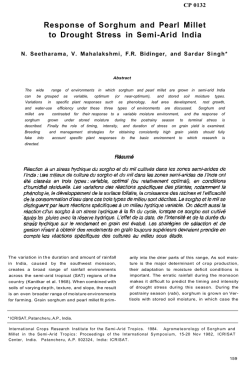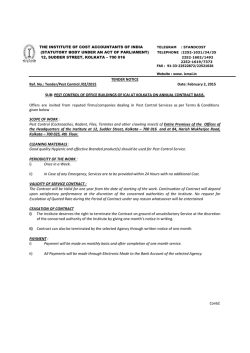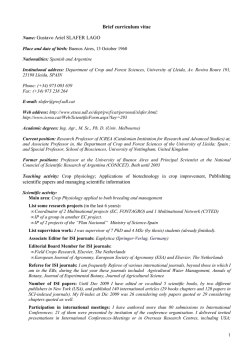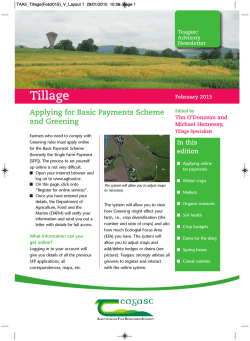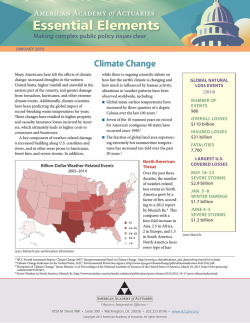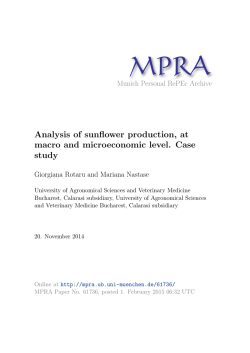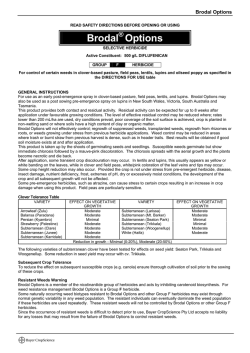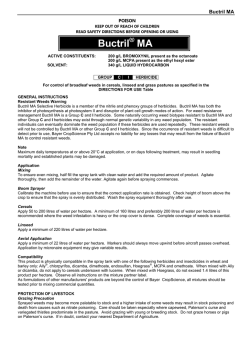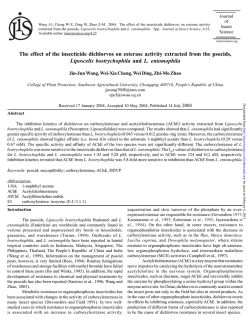
Pest Losses and Control of Damage on Sorghum in
Pest Losses and Control of Damage on Sorghum in Developing Countries The Realities and the Myths - J. C. Davies* There have been significant advances in sorghum research and considerable increases in world sorghum grain production and yield in the past decade. However, the sobering fact 1s that, with the notable exception of India, there has been only a minimal improvement in overall production from the countries where sorghum is used primarily in human food (Kanwar and Ryan 1976) and indications are that production trends will be negative before long in many countries (Ryan, rsonal communication). This is a,slruation that an be ignored only at our peril. It is a situation for which something can be done, but only if we take an objective look at our ideas-many of which are preconceived. We must realize that the solutions proposed and results obtained in the sorghum research field in developed countries, must be examined very critically before being adopted or utilized as blueprints for attacking the serious and urgent problems of increasing sorghum production, particularly in Africa. I make no apology. therefore, for 'slanting' my remarks today on entomology, towards the developing world situation. Even a brief scan of the sorghum literature shows that the developed world is exceptionally well catered for, both by the amount and quality of information being produced on sorghum in all scientific disciplines, including entomology. However, I suspect that in the 10 years since the last sorghum symposium, the number of research nd development workers, who are able to devote eir full time to the sorghum crop in Africa and the developing world has not increased to anywhere near the extent needed, to cope with the well documented problems of feeding their rapidly expanding populations. Indeed the number of sorghum research workers in the developing world may well have decreased! v b ' Director for International Coo~eration,ICRISAT I also make no apology for taking a rather simplistic approach and for not delvlng into the more fascinating scientific aspects of pest prob lems on the crop in the developing countries and the mbre esoteric proposals for tackling them. Sorghum as an Insect Food Sorghum must rate as one of the most favored plants, cultivated by man through the ages, as a host for pest Insects. Numerous l~stshave been produced cataloging well over 150 species as pests or potential pests of sorghum (Jotwan1et al. 1980; Seshu Reddy and Davies 1979). Fortunate ly, it remalns a truth, that the actual number of species which can be considered of major Importance are no greater now than they were when the last distinguished scientific gathering assembled As. at for the Sorghum in Seventies ~ y m ~ o s i u m that time, the most ubiquitous and serious in worldwide terms probably remalns the sorghum midge. Contarinia sorghicola (Harris and Harris 1968; Harris 19761-a pest which we should discuss a little later in the context of the realities and difficulties facing us as entomolog~sts.Many pests are of regional importance including the various armyworms, e.g., Spodoptera exempt8 (Brown and Dewhurst 1975) and the locusts. Schistocerca gregaria, Locusta m~graroriaand Nomodacris septemfasciata, particularly in the African context. These days, we tend to relegate locusts to the status of pests of the past-but I suspect that in the context of political upheaval and consequent problems of control strategy and the logistics of both aerial and ground survey and control, we would do well to keep a very jaundiced eye on their activities. The spectacular losses and damage, which can be caused quickty by both armyworms and locusts, could possibly Internatio~lCrops Rosearch Institute for the Semi-AriU Tropics. 1982. Sxghum in the Eighth: Pmmdtngl of the InumaionJ ~ymposiumon Sorghum. 2-7 Nov 81, Patancheru. A.P., India Pa~ncheru.A.P. India: ICRISAT. be'more important for the peoples of Africa even now than the more insidious enemies, which annually take their toll-the shoot fly, Atherigona soccata, the lepidopterous stem borers, Chilo partellus, Busseola fusca, the Sesamia spp and Eldana saccharins. The latter appears to be relatively more important in Africa now than it was in the early 1970s (Girting 1978). The omnivorous termite species take a steady, if unspectacular toll, but the true effect on yields is not assessed. Since the last conference we have made, as entomologists, little or no progress in determining the identity or extent of damage caused by the many hemipterous species found in the heads, although Bowden in 1965 drew attention to their possible importance. ~eitainly,there is no doubt that the last decade in lndia has seen Calocoris angustatus appear as a more than occasional pest locally, but we appear to know very little of the reasons for sudden population increases. While the importance of aphid species has been seriously viewed in the cooler temperate countries (Schuster and Starks 19731, in the developing countries the exact status of the various species has been little researched. Certainly, here at ICRISAT, late season attacks with high aphid counts in the head and associated honey dew and consequent mold growth, make them an object of speculation, if not of research. With the introduction of the tighter panicle, the importance of the many lepidopterous head worms both in lndia and Africa has changed-but this change has not been quantified in terms of damage. As early as the late 1950s, Doggett (1954) among others, was commenting on the numbers of Heliothis arimigera larvae in tight and protected panicles, possibly due to discourage ment of predation by birds, but possibly also to the increased protection afforded against insect and arachnid predation or improved habitat for survival. While increased Heliothis numbers may not in themselves have much effect on sorghum yields, we should be looking at the overall effects of such observations on the pest spectrum and yieicls of a range of crops, in view of the mixed cropping situation which the small farmsrs of the SAT use to spread their risk, The situation is one which is completely different from that in a developed agricultural economy, where even height and good panicle conformation are important, and harvesting and drying machinery are readily available to handle such cultivars in monoculture. As entomologists, we can look back on the last decade as one where the sorghum crop has not suffered the entomological equivalent of the Southern leaf blight disaster of the 1970s on maize in the USA or the downy mildew "epide mic" on pearl millet of the mid 1970s in India. I hope that we are all convinced that this was cold calculation and not luck-I do believe that screening techniques are surer in the developed world and contribute to safety margins in released cultivars, but there is room for considerable improvement. I view with wariness the tendency to believe that quick solutions to production problems for human food sorghum are possible by the transfer of established lines-commercial or otherwise-to developing countries. We are only at the very early stages of the incorporation of insect resistances into better agronomic and higher yielding types fully adapted to the SAT. Our screening capability in these situations is inade ate at the national level. The f~nanceto impro this vacuum is lacking. A great deal remains to be discovered about the biology of the pest species range on sorghum in the developing world. A glance at the impressive lists Will convince even the most skeptical that there is a potential, or actual, pest for every stage of the sorghum plant from seedling till after storage in almost all situations-climatic, edaphic and cultural. Additionally, we have been singularly fortunate in that the potentials of several insect species for disease transfer appear to have been relatively unutilized in sorghum. 'I Pest Attack and the True Loss Factor The references to significant pest losses in crops, and these probably included the progenitors 01 modern sorghum, are ancient and impeccablk and are mentioned in the Bible in Exodus 10 and Joel 1. While the potential losses in the high plains of Texas to midge are well quantified (Bottrel 19711, there are however, far less readily available sound data on losses from developing countries, where sorghum is a significant food crop. In these countries, particularly those of the semi-arid tropics with a rainfall of 600-1000 mm per annum. where sorghum is an important human food, the yields generally quoted are pitifully low-500 -700 kglha. A major reason given for this is pest attack. Certainly these yields compare very un- favorably with yields from the same cultivars on research stations within the SAT, which are frequently three or four times as high. These statistics are meaningful to governments and planners who hust consider the total production in feeding strategies for their populations-but how meaningful are they as statistics on which to base entomological research proposals? Most of us who have toured extensively in these areas "know" that yields on wellgrown, timely-sown sorghum on farmers' fields are more, by a factor d 3 or 4, than the average and "know" the level of inaccuracy inherent In the average estimates in official statistics-even the ones widely quoted yesterday. Clearly, a great deal could be done by the introduction of Improved agronomic practices even with existing cultivars and known research information and techniques. Possibly one of the few pests on,which some m evidence on losses for developing countries xists is the sorghum midge. As early as 1960, Nye (1960) commented that in Eastern Africa, it was a severe pest only on research stations and this is certainly so, at present, in some areas of West Africa. I do not think that the situation in East Africa has been looked at objectively since the 1960s. The situation in Nigeria appeared to be very different (Harris 1961). Extensive surveys there in the late 1950s indicated a 4% loss on some 250 000 acres (equivalent at that time to almost 2 million pounds sterling). Even within West Africa, the situation is far from uniform, however Bowden (1965) noted that in Ghana infestations (as opposed to losses) are seldom above 10- 15% and that quoted losses to midge are compounded by losses due to the head infesting hemiptera. The observation was reported to be possibly due to the cultivar being grown which had a relatively ompact head, but also possibly to the higher ainfall. In India, midge is often serious at research centers and undoubtedly important in "endemic areas" (Venugopal et al. 1975; Jotwani 1978) particularly where plantings are staggered, but from my own observations, it appears that in some endemic areas, the head infesting hemip tera may also be important contributory factors to the losses quoted. Actual data on losses due to shoot flies and stem borers are hard to ascertain. Fields badly damaged by shoot fly are spectacular when observed, but what do they mean in terms of yield loss to a whole area, or country, in a particular II P season? This cannot be sa~d to have been accurately assessed. Clearly, early sown crops are but lightly damaged, in all but a few seasons. Attempts to gauge the economlc threshold levels d for shoot fly, uslng ~nsecticides,in l ~ m ~ t eand 'blanket' applications, tend to show that Increments of yield in sorghum produced are often not significant nor economlc on research stations with the higher y~eldlevels relevant to these (Ingram 1959; Dav~esand Jowett 1970). Assessments of losses from the various insidlous stem borer to species in sorghum are even more d~ff~cult quantify. lngram (1958)commented that in Uganda, despite heavy attacks by Busseola fusca and Chrlo partellus, sorghum y~eldedwell. A similar susp~cionwas echoed by Harris (19621 for West Afr~ca,and subsequently supported by h ~ sfurther work (Harris 19641, where the use of ~nsecticides for control gave conflicting results w ~ t hregard to yield increments. Increases in yield per stand were obtained from bored stands. Th~s was presumably a function of either extra t~llerproduction or select~onof potentially h~gheryielding stems for attack by borers. Evidence has been produced quotlng correlations between length of tunnell~ng and y~eldloss. However, there are correlaseveral reports of disconcerting pos~t~ve tions between stem tunnell~ng,or number of borers per stem, and yield. Th~sfeature, which presumably IS a reflect~on of the sampling methods or cultivar used, does not appear to have been seriously researched. It m~ghtbe postulated that with the dynamic biolog~calsystems with which we are dealing, compensatory reactions mechan~smson from plants and discr~m~natory the part of insects are operating. So where does this put the pest problem in relation to the scheme of y~eldloss and In relation to other yield reducers such as poor plant estab lishment and final plant populat~on,drought, disease, parasitic weed and possibly most important of all, birds? It is important to know this at times of fund constraint and scarce resource allocation. The evidence of loss, except for the recorded catastroph~c"invasion" years when massive or a localized very severe pest attack is recorded, is pitifully poor. There is little reliable clearcut information on "normal" pest attack on "normal" crops. In relation to insect attack, it is suprising how often late-sowing is commented on as a factor in increased pest attack, but then late sowing or serial sowing is becoming more and more recognized as a small farmer technique (and ati apparently realistic one at that), for the avoidance of risk-be it from hail, extended rain or pointed massive pest attacking migratory pests. Do we have to balance losses in late sown crops against the insurance factor for those important years when these late sown crops are the ones which, even though poor, give the only sustenance in disaster years to 'on farm' families? The small farmer systems are clearly, and rightly, far more sophisticated than those of large-scale farmers, where modern technology has provided risk evading mechanization to assist in times of crisis, be it supplemental irrigation, spray planes, harvesters or crop driers or, in the developing country situation, cash reserves from other sources which are available to buy in food in years of scarcity. My conclusion from a study of the currently available loss data is, that if these were presented in a court of law, while the circumstantial evidence for pest loss is very strong, there is insufficient evidence to convict. Clearly, we cannot extrapolate the situation, as we know it with regard to pest loss, from the high farming situations of the developed world to developing country and particularly small farmer agriculture. We are, to quote a gentleman who must be justly famous, "in a different ballgame". In my view, as a basis for our forward strategy in sorghum for the 80s we have a responsibility as entomologists to evaluate, rather more carefully than we have, the losses actually suffered in local cultivars in the existing farmer situation, given current methods of production and agronomy. We also have to assist in projecting, realistically, what can be achieved in increasing production by introduction of new cultivars and their impact on both pest loss and pest status of the many insect species recorded from the crop. Shifts of pest status on cereals are not numerous, but some have been observed in the developed world; they ara not well documented in the developing world on sorghum, but have been seen even in the last decafis on millet in West Africa (Vercambre 1978). There is evidence from Latin America. Africa and India, of some species increasing in relative importance in the last decade. Summing up on pest loss, I would ask, do we really know the economically damaging pest species in the developing world other than in very localized or short term circumstances?We should not overlook the fact that even an insect such as sorghum midge was repeatedly missed by trained biologists in the past and the damage it caused had been variously reported as ranging from hail damage to blight. Do we really know the effects of the various pest or potential pest species on crop establishment, for instance, in small farmer situations? Could the losses in plant population caused by shoot fly be more important than those of borer in the stem, for instance? Do we have real estimates of the loss in the developing country situation as opposed to fancied extrapolated losses from developed country data? There is a school of thought that believes such research is not required-do we subscribe to this? I believe schemes already exist that could take on this task immediately and let us have reliable information speedily. A part of this excercise must be to arrive at more reliable production and average yield per hectare figures. An important point already commented on in this workshop, in this context, is the fact t * currently in developing countries, 'little of t r) sorghum produced enters established trade channels-it is mainly consumed on the farm-so how accurate are the means for.loss on which we justify our projects? Let me hasten to say that, I believe, the losses are real and the situation particularly with regard to 'invasive' pests very delicately balanced. Perhaps in any case, the disaster year information' more than justifies all entomological input-which is so slight in d e veloping countries. 1 Control Strategies for the Developing World The utilization of resistance as a control strategy in the developing world is one which has enormous practical relevance and additional emotion appeal. Like many others in this room, I hav worked with insecticides on both cash and food crops and with the latter, at the end of the day, the sheer magnitude of the problem of infrastructure and delivery of crop protection products to the small farmer and the crop, aside from questions of economic or socioeconomic practicality, force one to the view that the only thing that can be guaranteed is that the small farmer will plant a seed at the earliest posible time for his particular situation, in a particular season. Thereafter, he is at the mercy of forces often completely out of his control. a However, we are all a little euphoric about the very real problem of incorporating and utilizing the identified resistances from germplasm sources In the seed whim will eventually go to the farmer. The goal of pest resistant sorghum can only be achieved by a very concerted and dedicated effort, to integrate the worklngs of the many scientific disciplines involved in the effort to achieve final success. It is regrettably not a perfect world, and a true multidisciplinary approach does not come easily-all of us in our individual disciplines "know" and the fact of 'knowing' and the very real pressures of the systems in which work is carried out, with its emphasls on results and quick solutions, millgates against true fully integrated effort. There are, In developed countries, lncreaslngly strong economic and commercial forces drivlng and fueling true multidisciplinary effon.' However, in ost developing countries, the restrictedavailabily of trained staff places almost impossible strains on true multidisc~pl~nary effort. Often the men are not available to place in a team to tackle just the needs of sorghum: the breeder is often concerned with a range of food crops and the entomologist or pathologist has to give second or third priority to the crop. As a general rule. physiologists are not available and agronomists cover an impossibly large range of crops and the glamor field is farming systems, not sorghum agronomy. In the circumstances, it IS not surprising that the necessary close contacts and tlme for integration of knowledge, ideas and work plans are not satisfactory. It is also significant that knowledge obtained in one discipline or one country is often not available to another for a variety of reasons. As an example of what I mean, currently not far from here, another look is being taken at the desirable sorghum head type for the seml-arid troplcs, and h n particular. the advisability of more lax headed types than those generally preferred in recent years. Yet from the 1950s, there was considerable evidence, at least in Africa, that lax headed types were less susceptible to hemipterous head bugs and afforded more easy access to birds for predation of lepidopterous head worms. There was also evidence that grain molds were less of a problem in wet years, in situations where end-ofseason rains were frequent, because of the relative speed of drying after rainstorms. It must be conceded that lax heads do not conform to current ideas of a desirable head types-which R' are largely condltloned by concepts derived from hlgh Input mechanized agnculture-but our target clientele are the small farmers, whose o b lectlve 1s to produce more grain, more reliably, wlth reduced rlsk, to feed thelr lncreaslng famllles As ever more gloomy forecasts are made about the shortfalls In cereals In developing countries In Afrlca over the next two decades, we must be concerned I wonder lf Dr Blum, who is In our audlence today, feels that the sltuatlon In 1981 1s slgnlflcantly better than ~twas when he attended the last conference, wlth the sorghum for the decade theme, and sald "Plant breeders In general appear to lack an understandlng of Insects wlth regard to thew hosts and tend to regard the lnsect population as a flxed environment parameter, wlth all the consequent ~mpllcatlons"(Blum 1972) 1 belleve we are moving educationally In the correct dlrectlon, but I also belleve that there 1s a current danger of too much emphasls on the herltable reslstance characterlstlcs at the expense of the lnvestlgatlon of the overall entomolog~callmpllcatlons of the very complex characterlstlcs of crop production In relatlon to agrocllmatlc and ecologlcal factors and dynamlc lnsect b~ology I would perhaps extend the sentiment of Blum's statement to Incorporate workers In the ~nterdlsclpllnary areas of relevance to the successful breedlng of the sorghum crop to withstand lnsect attack, and not to conflne the statement merely to plant breeders In the context of cross dlsclpllne understandlng, further thought ~ e e d sto be given to the use of modern ~nsect~c~des In reslstance breedlng programs Thelr use appears to be a valld tool early In breedlng programs to ensure transfer of deslrable chsracter~sticsfor yleld and for good agronomic tralts However, excessive or prolonged use of lnsectlc~desInto late generation breedlng materlal 1s potentially dangerous, ~f we are endeavoring to produce su~tablyrobust materlal wlth lnsect reslstance for use on farmers' flelds It IS soberlng to reflect on Pradhan's (1971) forebod~ngsabout utlllzatlon of lnsectlcldal "umbrellas" In breedlng and the fact that release of 'superlor', but otherwise lnsect susceptible varletles. In the tropics will not really achleve anythlng Th~sIS a very real poss~b~l~ty and must be guarded agalnst The products of breedtng programs must be vlable for exlstlng farmers' cond~tlons,whlle havlng the potentla1 for Increased ylelds In lmproved or moderate to hlgh Input sltuatlons. The concept of chemical control of sorghum pests is a relatively recent introduction in North America (Jotwani and Young 1972). The concept was based on a rapid expansion of sorghum acreage and the development of high yielding hybrids in moderately high input conditions of fertilizer usage and mechanical plowing, using harvesting and drying techniques of high sophistication. I believe some of these concepts have a place in the developing world-particularly in Africa, if a serious food shortage is to be avoided. There are areas where, after a minimal amount of adaptive work, existing sorghum cultivars could be grown in rlverain irrigated areas on deep black soil rainfed plains with assured rainfall, to produce large amounts of food. Rapid adaptation of existing pest control strategies to suit SAT situations may be possible to protect such mass and exotic material-but little work on efficient application techniques has been done to date. The situation with reference to chemical control in developing countries outlined by Jotwani and Young at the last conference has not materially changed. Generally, the favorable results obtained in the work done on the sorghum areas of the developed countries have been followed by testing of the successful insecticides in the developing countries (Barry 1972; Sepswadi et al. 1971; Jotwani, 1978; Vedamoorthy et al. 1965). Many of the results have been good under research station and supervised conditions and spectacular increases in yields have been claimed. I am a little concerned that, to an extent, the use of insecticides has caused an upsurge of work which detracted from effort on the entomology of the crop. This was certainly so in the early 1970s. In general, there is little convincing evidence of the economic soundness of some of the recommendations made for insecticide use on sorghum, in developing countries, except in special high input, or at least high fertility, and possibly assured water situations. Many insects in the developing country situation, particularly midge, and possibly stem oorers, are not easily controlled economically with existing techniques. Certainly in the SAT areas, where water is such a problem, some of the spray volumes recommended for use are beyond the ability of the socioeconomic framework to supply. Answers must be found which utilize simpler application techniques involving either no water usage or at the least, minimal quantities. Dusts and granules have their own particular problems with regard to transport, storage and application techniques in the tropics. The words of caution stated by Jotwani and Young (1972) at the last conference, with reference to the numerous instances of failure to control pests and the importance of developing long range strategies, which do not rely entirely on insecticides, but integrate all the various methods-cultural, mechanical, biological, and resistance-are as true today as they were then. Progress has been made in India in education on the value of cultural methods and early sowing of sorghum, and plans have been made for detailed studies in the West African areas that could lead to integrated pest management. There is clearly however, in much of the developing world, a dearth of information on which to base these strategies and further a lack of any real conception of whether these are poss~bleto apply, or indeed are acceptable at the small farmer level, given the scarcity of resources and number .of qualifi extension staff. O Novel Methods of Control of Pests Much has been written and speculated about the use of more novel methods of control'worldwide, but despite the rapidly increasing level of understanding and the detailed and intricate work on insect produced chemicals-pheromones, juvenile hormones and chemically produced sterilants -the promise remains largely unfulfilled, as far as the less monetarily valuable crops such as sorghum are concerned. Several of the important pheromones of stem borers- Chilo Partellus (Nesbitt et al. 1979)and Busseola fusca (Hall et al. 1981)-have been identified and field tested with success. They appear, at this stage, to be at best useful research tools and at the worst possible eye catching glamor areas for research whicd could divert funds and scarce scientific talent from the difficult problems of pest control on the sorghum crop in developing countries. This, to a greater or lesser extent, also applies to the use of hormones and sterilants. In the area of insect physiology and feeding behavior, chemical content of sorghum cultivars and related chemical constitution of sorghum, very significant strides have been made over the past decade. Clearly, this work has direct relevance to the problems of breeding for insect resistance and the potential payoff is great, if simple field screening for identified chemicals can be developed (Fisk 1981; Woodhead et al. 1980). The researco area of insect physiology with possibly greatest significance to lepidopterous pest carryover between seasons, is aestivation and diapause behavior. Some pioneering work on this has been done in Kenya by Scheltes (19781, but much remains to be done. The complexites of the interrelated chemical and water balance factors are areas for fruitful research effort. At ICRISAT, some preliminary studies were done and this work must be expanded. Here is a fruitful area for collaboration with developed country institutions with their sophisticated equipment and techniques. Related to some of these chemical and physiological studies are the cultural methods of control. These are, by and large, worked out for many pest species in the developing world (Harris 64; Nye 1960; lngram 1958). Refinements I ave been proposed in the last few years (Adesiyun 1980). The extent to which many of these are acceptable to small farmers will be a task for the workers in the field of integrated pest management to determine. In closing, may I say that I have been deliberately provocative in places because I feel that the time left to show real impact on the sorghum food situation in developing countries is running out. The progenitors of the sorghums which will help us to overcome the problems should already be in "the system" or at least be there within the next 5 years-given the 10- 12 year lead time needed to get a proven line widely used by farmers. There has been an alarming increase in food imports into most West African countries in the last few years. The World Bank estimates suggest that while population has grown 2% a year throughout the area, food crop production has stagnated and in several countries, decreased. We need to exbmine. very seriously, some of our straightforward interpretations of developed country r e sults on monocrop shoner-term sorghums and their applicability to the erratic rainfall, poor soil, intercrop situations so prevalent in the sorghum areas of developing countries. In situations such as in India with a reasonable infrastructure, high land usage and high human populations, there have been striking advances in the 1970s resulting in grain surpluses using transformation strategies. However, even these mnditions do not hold good for much of the area which ICRISAT was built to serve. Iwould particularty draw attention in r this context to the relative neglect of red sorghums in our breedlng programs, when they are so readily utilized in large areas of Africa where a good brew is a food and where populations have learnt to use them satisfactorily. These sorghums have several useful characteristics: entomological. pathological, and birdw~se,when compared with some of the white gralned types, whlch are favored in current breeding programs. We should come away from this conference with a realistic assessment of what IS needed. what the real constraints to progress on the ground in these countries are and how we can contribute to overcoming them. The number of scientists working in the field on sorghum in developing countries is Inadequate and the number of entomologists even fewer. It IS useless to encumber these few with work on materials or ideas, which are of marglnal Importance to sorghum pest control and ultimately to sorghum production. What IS needed are plans developed on a multidisciplinary basis, to tackle the priority problems. These should be reassessed at this time with realism and urgency. References ADESIYUN, A. A, and AJAYI. 0. 1980. Control of sorghum stem borer. Busseole fusca, by partial burning of the stalks. Tropical Pest Management 26 : 1 13- 117. BARRY. D 1972. Chemical control of sorghum shoot fly on a susceptible variety of sorghum in Uganda. Journal of Economic Entomology 65 : 1 123- 1 1 25. BLUM.A. 1972. Breeding for insect reststance in crop plants with special reference to sorghum. Pages 398-410 in Sorghum in seventies, eds. N. G . P. Rao and L. R. House. N w Delhi. India: Oxford and IBH Publishing Co. BOTTRELL, D. G. 1971. Grain sorghum research in Texas. Texas Agricultural Experimental Station PR 2940, Cob lege Station, Texas. 35 pp. BOWDEN,J. 1956. New species of African stem boring agrotidee (Lepidoptera).Bulletin of Entomobgicsl R a search 47 : 415-428. BWN. J. 1965. Sorghum midge. Contarinis sorghicda r(Coq.1 and other causes of grain sorghum bss in Ghana. Bulletin 'of Entornobgical Research 169-189. BRENNIERE. J. 1970. Economic problems caused by insects which infest sorghum in West Africa. Pages 1-8 in IRAT Seminar on Sorghum and Millet. INGRAM, W. R. 1959. Experiments on the control of stalk borers on sorghum in Uganda. East African Agricuttural and Forestry Journal 25 : 184- 187. BROWN, E. S. 1970. Control of the African armyworm Spodoptera exempt8 Walk.)-an appreciation of the problem. East African Agriculture and Forestry Journal 35 : 237. JOTWANI, M. G. 1978. Investigations on insect pests of sorghum and millets with special reference to host plant resistance. Final Technical Report (1972-77). Research Bulletin of the Division of Entomology, IARI, New Delhi, India. 114 pp. Bkow~,E. S., and DEWHURST, C. F. 1975. The genus Spodoptera (Lepidoptera : Noctuidae) in Africa and the Near-East.Bulletin of Entomological Research 65 : 221 -262. DAVIES,J. C., and JowEn, D. 1970. The control of sorghum pests with insecticides in Eastern Uganda. East African Agriculture and Forestry Journal 35: 414-421. DOGGETT. H. 1954 Progress reports from experiment stations. season 1952-53. Tanganyika Territory, Lake Province Empire Cotton Growing Corporation, London. 20 PP. JOTWANI, M. G., and SUKHANI 1968. Seed treatment of sorghum for the control of shoot fly (Atherigone varia soccata Rond.) Pesticides Oct, 40-41 . JOTWANI.M. G., and YOUNG. W. R. 1972. Recent developments in chemical control of insect pests of sorghum. Pages 377-398 in Sorghum in seventies, eds. N. G. P. Rao and L. R. House. New Delhi: Oxford and IBH Publishing Co. JOWANI.M. G.,YOUNG, W. R.. and TEETES. G. L. 1980. Elements of integrated control of sorghum pests. F Plant Production and Protection paper, FAO, Rom 159 pp. FISK,J.. BERNAYS, E. A., CHAPMAN, R. F.. and WOODHEAD. S. 1981. Report of studies on the feeding biology of KANWAR, J. S., and-Ryn~,J. G. 1976. Recent trends in Peregrinus maidis. Report Core Project 27, Centre for world sorghum and millet production and some possiOverseas Pest Research. 33 pp. ble future developments. Paper presented at the Symposium on Production, Processing and Utilisation of Maize, Sorghum and Millets, Dec, CFTRI. Mysore. GIRLING,D. J. 1978. The distribution and biology of India. EMana saccharina Walker (Lepidoptera : hralidae) and its relationship to other stem borers in Uganda. Bulletin NYE.I. W. B. 1960. The insect pests of gramineous crop of Entomological Research 68 : 471 -488. in East Africa. Booklet Colonial Research Studies No. HALL,0 . R.. BEEVOR, P. S., CORK, A,. LESTER, R., NESBITT 31, London, UK: Her Majesty's Stationery Office. 48 BRENDA, F., NYIR~NDRA, G. K. C., PHIRINOTA, D. D., BLAIR, PP. B. W., and TANNOCK, J. 1981. The female sex pherROME.R. E., and PADGHAM. D. E. 1980. Report on omone of the maize stalk borer Busseole fusca (Fuller) sorghum stem borer. Ecology and behaviour 1977-78. Lepidoptera : Noctuidae, Identification and initial field Core Program Project 27, Centre for Overseas Pest trials. Zimbabwe Journal Agricultural Research 19. Research, London 52 pp. HARRIS,K. M, 1961. The sorghum midge, Contarinia sorghicole (Coq.) in Nigeria. Bulletin of Entomological SCHELTES, P. 1978. Ecology and physiological aspects of Research 55 : 233- 247. aestivation. Diapause in the larvae of two pyralid stall( borers of maize in Kenya. Published Thesis, Landboul HARRIS,K. M. 1962. Lepidopterous stem borers of whoge School, Wageningen. cereals in Nigerii. Bulletin of Entomologica! Research 53: 139-171. SCHUSTER, D. J., and STARK, S. K. J. 1973. Greenbugs components of host resistance in sorghum. Journal of HARRIS,K. P4. 1976. The sorghum midge. Annals of Economic Entomology 66 : 1131- 1134. Applied Biology 84 : 114-1 18. HARRIS, K. M., and HARRISELUABETH 1966. LOSSBSof African grain sorghums to pests and diseases. Psst Articles and News Summaries 14 :48-64. SEPSAWADI, P., MEKSONGSEE, B,,and KNAW, F. W. 1971. Effectiveness of various insecticides against sorghum shoot fly. Joumal of Economic Entomology 64 : 1509 -1511. INQRAM. W. R. 1958. Stalk borers associated with Graminew in Uganda. Bulletin of Entomological R e search 49 :367-383. SESHU REDDY,K. V., and DAVIES, J. C. 1979. Pests 01 sorghum and pearl millet and their parasites and predators recorded at lCRlSAT Center. lndii up to August 1979. Progress Report. Cereals Entomokgy No. 2. ICRISAT. G. L.. and JOHNSON.J. W. 1973. ama age assessment of the greepw on grain sorghum. Journal of Economic Entomology 66 : 1181 - 1186. ~EETES. ~~EDAMOORTHY, C., THOBBI,V. V., MARTI.0. H.. and YOUNG, W. R. 1965. Preliminary studies with seed and seed furrow application of insecticides for the control of the sorghum stem maggot A t h e w n a indica Malloch (Anthomyiidae).Indian Journal of Agricultural Science 35 : 14-28. &NUGOPAL, M. S.. SUBRAMANLAM, T. R., and MEEWSHI.K. 1975. Assessment of damage by sorghum midge. Contarinia soghimle (Coq.1 to certain sorghum lines. Sorghum Newsletter 18 : 65. ~ERCAMBRE, 0. 1978. Raghuva spp el Masalia sp CheniC s des chandelles du Mil en zone Sahelienne. I'Agro. rop. 33, 1 :62-79. R NWDHEAD,S., PADGHAM. D., and LEATHER, E. 1980. Insect feeding preferences and pbnt chemistry in sorghum cultivars. Report Core Project 27, Centre for Overseas Pest Research, London. 36 pp.
© Copyright 2026
